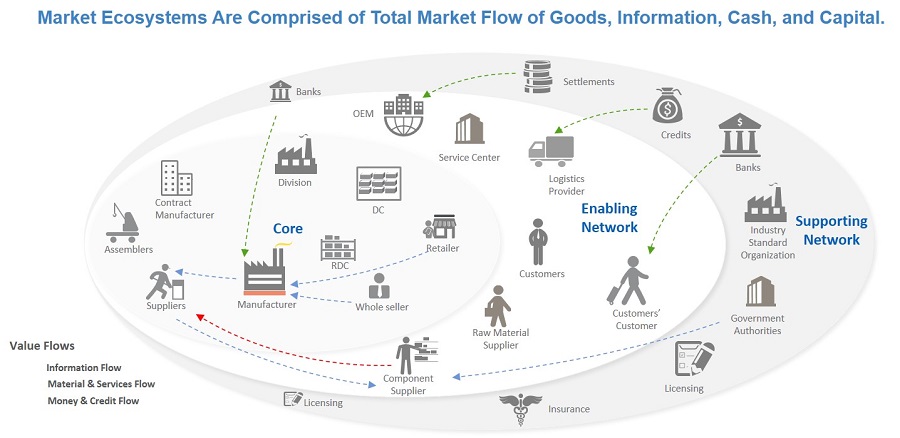Industry Talk
Regular Industry Development Updates, Opinions and Talking Points relating to Manufacturing, the Supply Chain and Logistics.The Next Big Thing: ERP4.0 (Ecosystem Resource Planning)?

As supply chain control tower technology matures beyond hype and into reality and multi-enterprise supply chain business platforms achieve similar levels of maturity, will the convergence of these technologies result in “the next big thing”? Let’s explore the evolution of ERP and the analogy of “airport control towers” to the strategies and capabilities of multi-enterprise supply chain business platforms. BTW: Gartner, please come up with a better name for this solution category.
Companies are realizing that their supply chain is not really a chain at all. It is a supply network and it is complex. To address this complexity, companies are implementing “control towers” to enable their enterprise supply network (ESN) with connectivity to trading partners for visibility and to optimize the flow of goods (inbound and outbound loads) within their ESN. However, as control towers are implemented, visibility to the flow of goods reveals that the ESN is simply a node in an Ecosystem Supply Network of Networks (ESNoN) community that is comprised of all of the participants in the market ecosystem including not only trading partners, but suppliers’, customers’, competitors’, and their suppliers’, customers’, and competitors’ ESNs as well. (And, not to mention, including all of the support enterprise networks as well).

Just as each airport has a control tower to manage and control inbound and outbound flight traffic, enterprise supply networks have a control tower to manage and control inbound and outbound loads of enterprise goods traffic. The emerging issue is that while these control towers have visibility and control over their loads, they don’t have visibility to all of the loads in the market ecosystem in which they operate. ESN complexity results not just from the enterprise flow of goods, but also to the flow of goods from competitor, supplier, and customer ESNs that must adapt to changing demand, resource constraints, bottlenecks to flow, capacity utilization/availability, and the plethora of variability, tradeoffs, and uncertainty that has plagued operations for years.
The solution lies in, what I will call is ERP4.0 or Ecosystem Resource Planning. I’ll leave it to you to determine whether it’s ERPFour, ERPFourOh, or ERPFourPointOh (LOL). The first breakthrough “wave” was Material Requirements Planning (MRP), followed by the second wave, Manufacturing Resource Planning (MRPII) and the third wave, coined by former Gartner analyst Erik Keller, Enterprise Resource Planning (ERP). Whether you call our current fourth wave the “Connected Age” as I did in my book, or Industry 4.0, or Business 4.0, the underlying enabling technology that will lead ESN maturity will be an ecosystem planning and optimization application suite, ERP4.0.
Individual airport control towers take their orders from the Air Traffic Control (ATC) system that is not a control tower; rather it is a network of control tower networks with visibility to all of the flight traffic in its airspace (ecosystem). Multi-Enterprise Supply Chain Business Platforms are connecting communities of commerce in market ecosystems. They are leveraging Business 4.0 digital technologies such as cloud computing, mobility, the IoT, AI/BI, etc. to optimize business processes across the market ecosystem.
The leading platform providers, E2open, One Network Enterprises, Infor Nexus, SupplyOn, and others are developing and/or acquiring operations applications that are evolving to the emergence of ERP4.0 suites that will enable ESNs to connect to an ecosystem platform that enables the optimization and synchronization of ecosystem flows of goods to lower the cost and complexity of integrating enterprise flows of goods within an ecosystem multi-enterprise traffic flow of goods. It’s an exciting time to be in the supply network management business. More to come.










